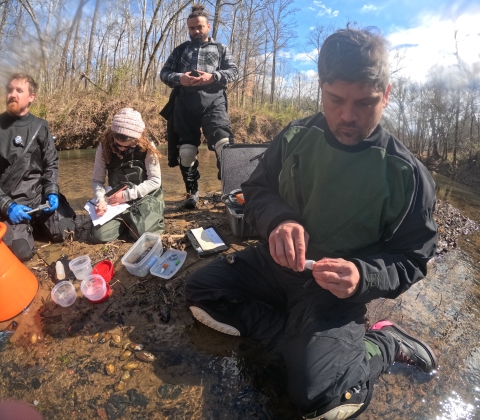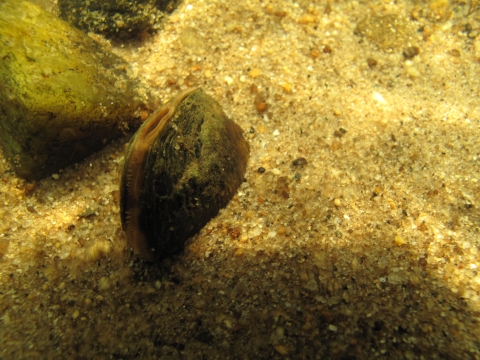Poplar, North Carolina -- Look no further than the islands of the Nolichucky River to see the devastation wrought by Hurricane Helene.
Where once the river swirled around the oaks, hickories, and poplars, now the islands are stripped bare of all greenery. They’re no more than rock outcroppings posing little resistance to the river renowned for its beauty, strength, and wildness. In spots, huge boulders have taken up residence where before there were none. Once-anchored boulders were whisked downstream, testament to the force of the river drunk on two feet of rain. And much of the Nolichucky’s bedload was scooped up and deposited on the river’s banks or surrounding fields.
Helene, in late September, killed 106 people and destroyed more than 1,000 homes across a wide swath of western North Carolina. Thousands of miles of roads, bridges, culverts, and train tracks, including along the Nolichucky, were crumpled like Kleenex. Roughly 200,000 acres in the Pisgah and neighboring national forests and parks suffered “catastrophic damage.”
In all, Helene caused $60 billion in damages and recovery and reconstruction costs, according to state officials.
All that, though, is calculated above the water lines of the Nolichucky, Toe, Cane, Pigeon, French Broad and other rivers that course through the mile-high mountains into Tennessee and beyond. But there was serious damage, too, below the water lines to the fish, mussels, salamanders and other animals that live largely out of sight. Their homes washed away or were covered in dirt. Their food, mostly plants, algae and bugs, disappeared downriver too. Locals tell of hellbender salamanders and rare mussels discovered dead along the muddy banks.
The remaining trees are greening up now as the bulldozers and dump trucks trundle alongside rivers rebuilding roads, bridges, and railroad tracks. It’s spring and time for the biologists to get back in the field to survey the damage done to the underwater animals.
“In places, the bedload is missing, the banks are missing, the trees are missing. Everything is gone and animals probably didn’t make it,” said Jason Mays, a fisheries biologist in North Carolina with the U.S. Fish and Wildlife Service. “But I take an optimistic view because not every area was hit equally hard. If you look at the entire Appalachian Mountains, there are enough areas that are stable that will be able to bounce back. Maybe, in a five- or 10-year timeframe, you may not notice the difference.”
He added, though, that “the Nolichucky worries me the most.”
“Have you seen my house”
Hurricane Helene had been downgraded to a tropical storm by the time it hit the Appalachians. Her rains, though, pummeled the region. Asheville got 14 inches. Mount Mitchell – the tallest mountain in the East at 6,684 feet and the headwaters of the Nolichucky – got two feet. Helene’s damage was near-apocalyptic. Roads, homes, and businesses in Asheville were washed away. The city’s water system was destroyed, leaving thousands of residents without water for weeks. Much of downtown Chimney Rock was simply swept away by the rampaging Rocky Broad River. The Pigeon River trashed, and closed, Interstate 40 near the North Carolina-Tennessee border.
Erwin, Tennessee, on the western edge of the Appalachians where the Nolichucky finds room to roam, was hammered by Helene. The Unicoi County Hospital was inundated; helicopters plucked patients from the roof. Flood waters swept five employees of Impact Plastics to their deaths.
Poplar, nine mountainous miles upriver from Erwin, suffered grievously; massive trees uprooted and upside down; a train trestle tossed aside like a giant’s plaything; road shoulders replaced by sandy beaches; house pads swept clean. A sign, on two sheets of metal siding, read:
“Have you seen my house??
Tell it to come back!”
All that rain cascaded off the tall mountains into the Nolichucky bringing dirt, rocks, and trees along for the ride. The flooding was locomotive-like, a muddy, detritus-filled tsunami overwhelming everything in its way. Including salamanders and mussels.
“The hellbender is very widely distributed across the mountains of North Carolina, so where the damage was maximum, their populations were clearly effected,” said Mays. “But in other places, they should be able to rebound quickly.”
The eastern hellbender – everybody's favorite slimy salamander with charmingly descriptive nicknames like “Allegheny alligator" "mud devil," and "lasagna lizard" – was already in bad shape before Helene hit the Appalachians. Recently proposed for listing as an endangered species threatened with extinction across its range, the hellbender lives underwater in 15 states from Mississippi to New York. (It’s already listed as endangered in Missouri.) Large-headed, heavy-lidded and wrinkled, the sallies can grow 30 inches in length. And they’re covered in a slimy, mucus-y substance that affords another fun nickname: “snot otter.”
Historically, an estimated 626 different populations of eastern hellbenders were alive and healthy in the east. Today, 373 populations exist, and 57 of them are declining, according to the animal’s Species Status Assessment compiled by the Service. Yet nearly half of the nation’s surviving hellbender populations are found in the Tennessee River’s drainage area, primarily the mountains of western North Carolina, eastern Tennessee, and northern Georgia.
They like the cool, fast-flowing, oxygen-rich, pebble-strewn streams of the Appalachians. Threats, though, are myriad across the blue-green mountains, primarily dirt, sand, rocks, minerals, and other sediments that cover up hellbender habitat and breeding grounds. The earth gets churned up by development, tree-cutting, off-road vehicles, and gravel mines. Stochastic events, like a hurricane’s random terror, are also hellbender killers.
“It’s going to take a long time, to be honest, to figure out the hellbender’s status now after this huge, life-changing event,” said Lori Williams, a conservation biologist and salamander expert with the North Carolina Wildlife Resources Commission. “Helene has now made things more urgent and the (proposed) listing has made things more urgent. We need to repair streams as best, and as fast, as we can. We have to prioritize the worst of the worst. The world is changing around us and there will be more storms like Helene around the bend.”
Return to the rivers
Williams and "an Army of folks” are now out in the streams of western North Carolina – the Nolichucky, Toe, Cane, French Broad, Swannanoa, Watauga, and New rivers -- looking for hellbenders and mussels. They’re sampling water quality and examining habitats: boulders, bedloads, shoals, bank cuts, tree overhangs, river widths. They’ll take genetic samples of the water to determine if hellbenders have recently passed through a particular stretch of stream.
Mays, the Service biologist, investigated hellbender habitat within a few weeks of Helene. The going was rough: roads and bridges were washed out; dump trucks and bulldozers impeded travel; contaminated and trash-strewn rivers prohibited extensive surveys. Mays, with a colleague, used glass-bottomed buckets to scan stream beds in the Little and French Broad rivers. Some streams, with broad shoulders and room for floodwaters to spread, fared well.
As the temperatures warm, and the contaminants dissipate, biologists will get back in the rivers with masks and snorkels for more precise surveys. Appalachian elktoe mussels, for example, start spawning once water temps reach 18 degrees Celsius, typically in late April. Mays plans a kayak trip through the Nolichucky Gorge – a whitewater paradise with Class III-IV rapids named Rollercoaster, On The Rocks, and Surprise -- in search of the federally endangered mussels and hellbenders. He’ll end up (hopefully) in Erwin where the Nolichucky leaves the Blue Ridge Mountains and, finally, slows. Helene, though, trashed the upper reaches of the river in Tennessee too.
“I don’t think anyone knows the true extent of the impact until we get out there and look,” said Andy Ford, a Service biologist and mussel expert in Tennessee. “We’ve got some species that the Nolichucky is vital for, including the oyster mussel. There were only two native populations left before the hurricane.”
The Erwin National Fish Hatchery, two miles from the river, avoided Helene’s wrath. But the hatchery might play a key role in the Nolichucky’s restoration. Erwin, typically, produces 20 million trout eggs each year that end up in various federal, state and Tribal waterways. It will propagate some endangered aquatic species this year too, including the oyster mussel and the Alabama lampmussel. It had planned to grow out some baby Appalachian elktoes, but Helene had other ideas.
“We anticipate actively propagating the species next year, hopefully from Nolichucky River stock, if we can find enough to work with,” said Tyler Hern, the supervisory fish biologist at the Erwin hatchery.
Down, not out
It has been a half year since Helene devastated the southern Appalachians. Life, in many places, seems normal. The redbuds and dogwoods that dot the hillsides bloomed. Interstate 40 re-opened in late February, albeit with only one lane in each direction. Asheville’s water is back on. The armada of dump trucks on winding, riverside roads attests to the resurgence of Poplar and other hard-hit towns.
But nobody’s under any illusion that Helene was a one-off. Hurricanes, and storms in general, are intensifying and worsening.
The year 2024 takes its place amidst the horrific pantheon of previous killer storms across the southern Appalachians: 1916; 1929; 1940; 1957; 1985; 1989; 1996; 2004; 2021.
“I remember (Tropical Storm) Fred in 2021. It destroyed the Pigeon River and part of the upper French Broad and then, three years later, we had this ‘thousand-year’ event,” said Williams, the hellbender biologist. “We’re having these major storms every 10-15 years and that’s not a good trend. It’s going to happen again.”
Aquatic animals, though, have survived catastrophic events before.
“If flooding is the only impact, hellbender populations could rebound quickly,” Mays said. “There’ll be a small subset of rivers where their populations were knocked back – conceivably to zero – but I don’t think that’s the most likely scenario. We’ll still have something to work with.”
Salamanders and mussels in the headwaters or tributaries of rivers are more likely to have avoided the deluge of sediment and rocks and survived. Mays and Williams look to endangered species listings as possible saviors for hellbenders and other critters. If listed, a species is in line for more federal protection, recovery, and habitat restoration dollars. It could also hurry along propagation efforts at federal fish hatcheries.
“Let’s say in five years, under a good scenario, the Cane River settles back down and, if you have the funding and support, the state and the feds will do their best to reintroduce mussels, fish, hellbenders, whatever,” Mays said. “We may be down, but we’re not out.”
Note: The eastern hellbender is proposed for listing.






